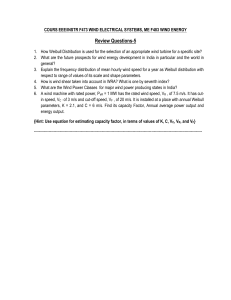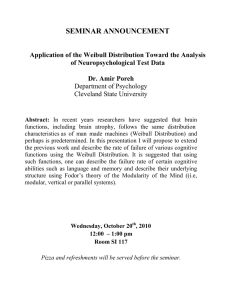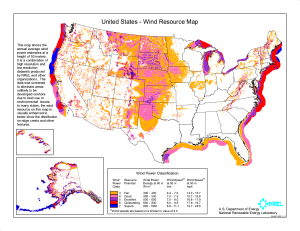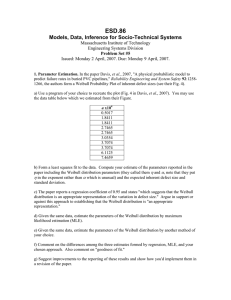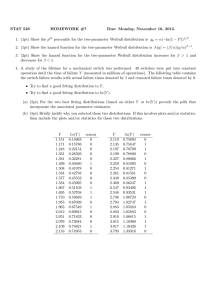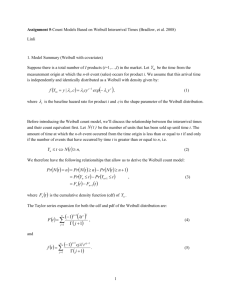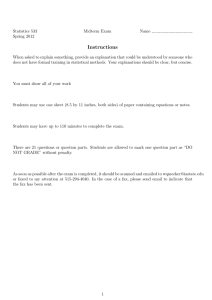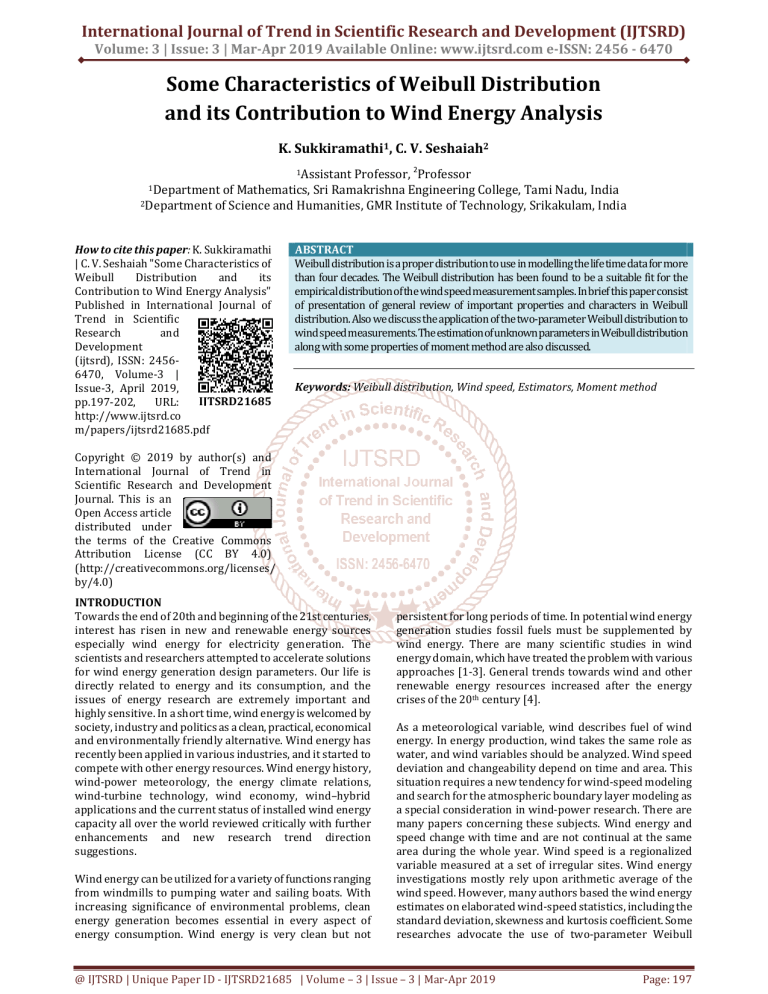
International Journal of Trend in Scientific Research and Development (IJTSRD)
Volume: 3 | Issue: 3 | Mar-Apr 2019 Available Online: www.ijtsrd.com e-ISSN: 2456 - 6470
Some Characteristics of Weibull Distribution
and its Contribution to Wind Energy Analysis
K. Sukkiramathi1, C. V. Seshaiah2
Professor, 2Professor
1Department of Mathematics, Sri Ramakrishna Engineering College, Tami Nadu, India
2Department of Science and Humanities, GMR Institute of Technology, Srikakulam, India
1Assistant
How to cite this paper: K. Sukkiramathi
| C. V. Seshaiah "Some Characteristics of
Weibull
Distribution
and
its
Contribution to Wind Energy Analysis"
Published in International Journal of
Trend in Scientific
Research
and
Development
(ijtsrd), ISSN: 24566470, Volume-3 |
Issue-3, April 2019,
IJTSRD21685
pp.197-202,
URL:
http://www.ijtsrd.co
m/papers/ijtsrd21685.pdf
ABSTRACT
Weibull distribution is a proper distribution to use in modelling the life time data for more
than four decades. The Weibull distribution has been found to be a suitable fit for the
empirical distribution of the wind speed measurement samples. In brief this paper consist
of presentation of general review of important properties and characters in Weibull
distribution. Also we discuss the application of the two-parameter Weibull distribution to
wind speed measurements. The estimation of unknown parameters in Weibull distribution
along with some properties of moment method are also discussed.
Keywords: Weibull distribution, Wind speed, Estimators, Moment method
Copyright © 2019 by author(s) and
International Journal of Trend in
Scientific Research and Development
Journal. This is an
Open Access article
distributed under
the terms of the Creative Commons
Attribution License (CC BY 4.0)
(http://creativecommons.org/licenses/
by/4.0)
INTRODUCTION
Towards the end of 20th and beginning of the 21st centuries,
interest has risen in new and renewable energy sources
especially wind energy for electricity generation. The
scientists and researchers attempted to accelerate solutions
for wind energy generation design parameters. Our life is
directly related to energy and its consumption, and the
issues of energy research are extremely important and
highly sensitive. In a short time, wind energy is welcomed by
society, industry and politics as a clean, practical, economical
and environmentally friendly alternative. Wind energy has
recently been applied in various industries, and it started to
compete with other energy resources. Wind energy history,
wind-power meteorology, the energy climate relations,
wind-turbine technology, wind economy, wind–hybrid
applications and the current status of installed wind energy
capacity all over the world reviewed critically with further
enhancements and new research trend direction
suggestions.
Wind energy can be utilized for a variety of functions ranging
from windmills to pumping water and sailing boats. With
increasing significance of environmental problems, clean
energy generation becomes essential in every aspect of
energy consumption. Wind energy is very clean but not
persistent for long periods of time. In potential wind energy
generation studies fossil fuels must be supplemented by
wind energy. There are many scientific studies in wind
energy domain, which have treated the problem with various
approaches [1-3]. General trends towards wind and other
renewable energy resources increased after the energy
crises of the 20th century [4].
As a meteorological variable, wind describes fuel of wind
energy. In energy production, wind takes the same role as
water, and wind variables should be analyzed. Wind speed
deviation and changeability depend on time and area. This
situation requires a new tendency for wind-speed modeling
and search for the atmospheric boundary layer modeling as
a special consideration in wind-power research. There are
many papers concerning these subjects. Wind energy and
speed change with time and are not continual at the same
area during the whole year. Wind speed is a regionalized
variable measured at a set of irregular sites. Wind energy
investigations mostly rely upon arithmetic average of the
wind speed. However, many authors based the wind energy
estimates on elaborated wind-speed statistics, including the
standard deviation, skewness and kurtosis coefficient. Some
researches advocate the use of two-parameter Weibull
@ IJTSRD | Unique Paper ID - IJTSRD21685 | Volume – 3 | Issue – 3 | Mar-Apr 2019
Page: 197
International Journal of Trend in Scientific Research and Development (IJTSRD) @ www.ijtsrd.com eISSN: 2456-6470
distribution in wind velocity applications. Their suggestions
are taken as granted in many parts of the world for wind
energy calculations.
The aim of this paper is to review the characteristics and
properties of the Weibull distribution. Then the
interpretation of the parameters using moment method and
the contribution of Weibull distribution to wind speed
evaluation are discussed.
Weibull Distribution:
In the early 1920s, there were three groups of scientists
working on the derivation of the distribution independently
with different purposes. Waloddi Weibull was one of them
[5,6]. The distribution bears his name because he promoted
this distribution both internationally and interdisciplinary.
His discoveries lead the distribution to be productive in
engineering practice, statistical modeling and probability
theory. The Weibull distribution is widely used in reliability
[7].Thousands of papers have been written on this
distribution and it is still drawing broad attention. It is of
importance to statisticians because of its ability to fit to data
from various areas, ranging from life data to observations
made in economics, biology or materials reliability theory.
The Weibull distribution is the most widely used life time
distribution. It is used as a model for life times of many
manufactured items such as vacuum tubes, ball bearings and
electrical insulation. It is also used in biomedical
applications, for example as the distribution for life times to
occurrence (diagnosis) of tumors in human populations or in
laboratory animals. Further the Weibull distribution is the
suitable model for extreme value data such as the strength of
certain materials. Recently empirical studies have shown
that the Weibulll distribution is superior to the classical
stable distributions inclusive the normal distributions, for
fitting empirical economic data.
Probability density function:
The Weibull distribution gives a good match with the
experimental data. This is characterized by the shape
parameter k and scale parameter c(m/s). The Weibull
distribution is often used in the field of life data analysis due
to its ability to fit the Gamma distribution and normal
distribution and interpolate a range of shapes in between
them.
The probability density function is given by
paper. The value of shape parameter has remarkable effect
on the behavior of Weibull distribution [8,9]. The following
plot shows the effect of different values of the shape
parameter k.
TABLE 1 WEIBULL DISTRIBUTION SHAPE PARAMETER K
PROPERTIES
Shape Parameter
Probability Density Function
0<k<1
Exponentially decay from infinity
k=1
Exponentially decay from /mean
1<k<2
Rises to peak and then decreases
k=2
Rayleigh distribution
Has normal bell shape appearance
Has shape very similar to type 1
k>10
extreme value distribution
FIGURE1 WEIBULL DISTRIBUTION PROFILE AT VARIOUS
K
Scale parameter c
The value of scale parameter c has a different effect on the
Weibull distribution. It is related to the location of the
central portion along the abscissa scale. s From Figure 2 we
can say that
If c is increased, while k is constant, the Weibull
distribution gets stretched out to the right and its height
lowers.
If c is decreased, while k is constant, the Weibull
distribution gets pushed in towards the left, and its
height increases.
This is because the area under the density must be unity.
(1)
FIGURE 2 WEIBULL DISTRIBUTION PROFILE AT VARIOUS
C
and the cumulative distribution function is
(2)
where v is the wind speed, k is the shape parameter and c is
the scale parameter.
Interpretation of Weibull parameters:
The aim of this section is to review the parameters namely
the shape parameter, scale parameter and hazard rate of the
distribution. Also the interpretation of the parameters and
their physical meaning will be introduced.
Shape parameter k:
Weibull is a versatile distribution that can take on the
characteristics of other types of distributions based on the
value of the shape parameter. The value of k is equal to the
slope of the line in a probability plot on Weibull probability
@ IJTSRD | Unique Paper ID - IJTSRD21685 | Volume – 3 | Issue – 3 | Mar-Apr 2019
Page: 198
International Journal of Trend in Scientific Research and Development (IJTSRD) @ www.ijtsrd.com eISSN: 2456-6470
TABLE 1 CHARACTERISTIC OF WIND SPEED
Annual mean
At 10 m Height Indicated
wind speed
value of wind resource
< 4.5 m/s
Poor
4.5 – 5.4 m/s
average
5.4 – 6.7 m/s
Good
> 6.7 m/s
Exceptional
Concept of Hazard rate
The parameter of interest here is the hazard rate, h(v). This
is the conditional probability that an Equipment will fail in a
given interval of unit time given that it has survived until
that interval of time. It is, therefore, the instantaneous failure
rate and can in general be thought of as a measure of the
probability of failure, where this probability varies with the
time the item has been in service. The 3 failure regimes are
defined in terms of hazard rate and not, as is a common
misconception, in terms of failure rate. [10]
where the mean is denoted by μ and the standard deviation
is denoted by σ.
The kurtosis is given by
[Γ
2
where
− Γ12
(
]
2
Γi = Γ 1 + i
k
)
A main reason for its popularity is that it has a great
variety of shapes this makes it extremly flexible in fitting
data, and it has been found to provide a good
description of many kinds of data.
As
the hazard rate of the distribution increases
to infinity if
Definition 1:
One of the most important quantities characterizing life
phenomenon in life testing analysis is the hazard rate
function defined by
− 6Γ14 + 12Γ12 Γ2 − 3Γ1Γ3 + Γ4
γ2 =
and is constanat for
. Among
all usual life time distributions no other distribution has
this property. This property makes the Weibull
distribution suitable in applications where a decreasing
hazard tendency distribution or an increasing hazard
tendency distribution is required.
It contains the exponential distribution as a special case
where
, further it has the following strong
The hazard rate for the Weibull distribution is expressed
relation to the exponential distribution. If X has a
Weibull distribution then
is exponentially
by
The cumulative hazard function is given by
Lemma1:
The hazard rate function of a Weibull distribution has the
following properties.
1. If k=c=1 then the hazard rate is unit.
2. Only if c=1 then the hazard rate is increasing for k>1 and
decreasing for k<1.
3. Only if k=1 then the hazard rate is other than unity.
Proof:
1. It is clear that k=c=1 then h (v)=1.
2. If c=1 then h(v)=kvk-1.which is increasing for k>1 and
decreasing for k<1.
3. It is clear that if k=1 then h(v)=1/c. For different values
of c it will be a constant other than unit.
Some of the properties of Weibull Distribution:
In this section we have discussed some of the properties of
Weibull distribution and its associated theorems. In my
previous work I have used two mixture probability
distributions namely Weibull-Gamma and Weibull-Normal.
So here we mentioned the mean and variance of those
properties also.
distributed. So by appropriate changing of the scale we
get the exponential distribution from the Weibull vice
versa.
The Weibull distribution is one of the three possible
types of minimum stable distributions. Let
be identically independenty distributed random
variables with common distribution function F. If for
each n there exists constants
and
such that
then
distribution of X is called minimum stable. It can be
shown that there exist three types of such distributions.
If have a Weibull distribution when shape parameter
k,
that
the
it
is
easily
shown
. This stability
property is an expression of a deeper limiting property.
If F(0)=0 and F(t) behaves as
for some possitive c
and
k
as
from
above
then
converges in distribution to
If X has a Weibull distribution then its mean
the Weibull distribution with shape parameter k. This
characteristics property makes the Weibull distribution
a natural model for extreme value data
rth moment about the origin is
The skewness is given by
3
Γ1 + c 3 − 3µσ 2 − µ 3
k
γ1 =
3
σ
Theorem 1:
The inverse Weibull cumulative function can be expressed in
closed form.
Proof:
The probability density function and cumulative distribution
of Weibull are (1) and (2) respectively.
@ IJTSRD | Unique Paper ID - IJTSRD21685 | Volume – 3 | Issue – 3 | Mar-Apr 2019
Page: 199
International Journal of Trend in Scientific Research and Development (IJTSRD) @ www.ijtsrd.com eISSN: 2456-6470
Equating
(2)
to
u
where
0<u<1,
we
get
.
Which shows that the inverse Weibull cumulative function
can be expressed in closed form.
Theorem 2:
The Weibull Distribution has the scaling property.
Let t be a positive real constant. The transformation
is a 1-1 transformation from
and
with inverse
.
Also the Jacobian is given by
.
Proof:
Therefore by the transformation technique the probability density function of U is
,
which shows the scaling property of Weibull distribution.
Mixture Distributions:
A mixture distribution is a weighted average of probability distribution of positive weights that sum to one. The distributions
thus mixed are called the components of the mixture. The weights themselves comprise a probability distribution called the
mixing distribution.
Definition 2:
A random variable X is said to have a weibull mixtured distribution if its probability density function is defined as
(3)
where g(x,α) is a probability density function. The name of weibull mixture distribution comes from the fact that the
distribution (3) is the weighted average of g(x,α) with weights equal to the ordinates of Weibull distribution.
Definition 3:
If X follows a Weibull Mixture of Normal distribution with parameters k and c then the density function is given by
dr ,
with parameters k and c such that
.
Proposition 1:
If X has a Weibull mixtures of Normal Distribution with parameters k and c then its mean and variance are 0 and
respectively.
Definition 4:
A random variable X having the density function
is defined as Weibull Mixture Gamma Distribution with parameters
Proposition 2:
If X denotes a Weibull Mixture of Gamma variate with parameters
where as
then its mean and variance are
And
respectively.
Estimation of the parameters using the method of
moments:
This section discusses the statistical fitting of wind speed
measurement data to the Two-parameter Weibull
distribution, which has been recognized as a suitable fit for
wind speed distribution .To be more precise, what is meant
of “wind speed” here is the periodic (e.g. per minute)
measurement of wind speed at a particular location, height
and in a certain direction (e.g. southward). Clearly, wind has
a velocity at any given time, i.e. a speed as well as a direction.
Wind speed measurements, thus, correspond to the
magnitude of wind velocity in the measurement direction,
which is argued to closely resemble a Weibull distribution
[11, 12].
Weibull distribution (Weibull, 1951) has many applications
in engineering and plays an important role in reliability and
maintainability analysis. The Weibull distribution is one of
@ IJTSRD | Unique Paper ID - IJTSRD21685 | Volume – 3 | Issue – 3 | Mar-Apr 2019
Page: 200
International Journal of Trend in Scientific Research and Development (IJTSRD) @ www.ijtsrd.com eISSN: 2456-6470
the extreme-value distributions which is applied also in
optimality testing of Markov type optimization algorithms
(Haan (1981), Zilinskas & Zhigljavsky (1991), Bartkute &
Sakalauskas (2004)). Because of useful applications, its
parameters need to be evaluated precisely, and efficiently.
The parameter estimation will be primarily explained in the
following chapters. Apart from the simplicity and ease with
which the parameter estimates and the estimated
distribution function can be constructed, the wide
applicability of Weibull distribution depends on several
attractive features which it possesses and in the following
we mention most important moment method. Normally
there are two different approaches for obtaining the point
estimator for parameter is known. Namely classical method
and decision theoretic approach. Now we outline some of the
most important methods for obtaining estimators. Most
commonly used methods under classical estimation are as
follows
Definition 6:
Any function of the random sample
being observed say T (
Method of moment’s fitting:
It can be shown that the theoretical moments of a
distribution are reasonably approximated by their
observational counterparts when the number of sample
values is sufficiently large. The method of moments utilizes
this fact to estimate the parameters of a distribution.
Theoretical moments, which are functions of the unknown
parameters, are equated to their corresponding sample
moments. Estimates of the parameters are obtained by
setting up as many equations as there are parameters, and
solving these equations in terms of the sample moments. The
goal of Moment method is to estimate the parameters that
yields theoretical value of the distribution . The first two
moments of the Weibull Distribution are given as
and
.
Let
(4)
Also
that are
) is called a Statistic.
Definition 5:
If a statistic is used to estimate an unknown parameter of
a distribution, then it is called an Estimator and a particular
is called an
value of the estimator say
estimate of .The process of estimating an unknown
parameter is known as estimation.
Preposition 3:
The function H(k) is strictly monotone decreasing, has a
unique root in
that converges to a negative
value as
.
Proof:
The derivative of H(k) is given by
Some characteristics of estimators:
Various statistical properties of estimators can be used to
decide which estimator is most appropriate in a given
situation.
where
. From calculus we know that if
the derivative of a continuous function is continuous and
negative, the function itself is strictly monotone decreasing.
Biased and Unbiased estimator:
An estimator is said to be unbiased for
the solution k is unique.
If
In
If
then
over estimates .
If
then
under estimates .
If
Since H(k) is unique we conclude that
if E( )= .
then we say that is biased.
general the bias of an estimator
.
is unbiased then of course
is
.
and thus
Theorem 3:
Let {vi , i=1,2,….n} be a finite set of wind speed observations
where
,
and
Such that
. Then for
H(k)>1 and there exists a unique pair of
that gives
and
.
Good Estimators:
In general a good estimator
has the following properties.
Proof:
Always
is unbiased for
has small variance.
Unbiasedness:
A statistic T is an unbiased estimator of the parameter
and
.
Gamma function is always continuous on
continuous.
.Hence (4)
iff
Now
Example: Let
be a random sample of size three
from a Normal population of
. The statistic
is an unbiased estimate of .
Since
Also
Using intermediate theorem for the above results we can say
to
. As
that there exists a solution
well as by proposition the solution k is unique.Therefore for
a unique k then
. Concluding the proof[14].
=
@ IJTSRD | Unique Paper ID - IJTSRD21685 | Volume – 3 | Issue – 3 | Mar-Apr 2019
Page: 201
International Journal of Trend in Scientific Research and Development (IJTSRD) @ www.ijtsrd.com eISSN: 2456-6470
Illustration of moment method using example:
Here we have presented four numerical methods namely
Graphical method(GM), Emperical Method(EM), Moment
method(MM) and Energy pattern Factor method(EPFM) for
estimating Weibull parameters using wind speed data
collected at Jogimatti located in Chitradurga district,
Karnataka, India over a period of 20 years with mast height
of 20m at Latitude N at 14 ̊ 09”49’, Longitude E at 76 ̊
23”56’and its performance is compared to others by using
RMSE,
χ
2
and
statistical tests .
TABLE II-The Weibull parameters k and c
Weibull
GM
EM
MM
EPFM
parameters
k
2.6260
2.5987
2.5801
2.5010
c
9.1901
9.2130
9.2142
9.2030
TABLE: III-Statistical Tests
TESTS
GM
EM
MM
EPFM
RMSE
0.0319
0.0315
0.0314
0.0306
χ2
0.0011
0.0010
0.0010
0.0009
0.9585
0.9595
0.9599
0.9619
FIGURE 3 COMPARISON BEWEEN THE ESTIMATED
CUMULATIVE DENSITY
References
[1] Cook NJ. Confidence limits for extreme wind speeds in
mixed climates. Journal of Wind Engineering and
Industrial Aerodynamics 2004; 92:41–51.
[2] Davenport AG. The application of statistical concepts to
the wind loading of structure. Proceedings of
Institution of Civil Engineering 1962; 19: 449–71.
[3] Deaves DM, Lines IG. On the fitting of low mean wind
speed data to the Weibull distribution. Journal of Wind
Engineering and Industrial Aerodynamics 1997;
66(3):169–78.
[4] Sayigh A. Renewable energy—the way forward. App.
Energy 1999; 64:15–30.
[5] W. Weibull, A statistical theory of strength of materials,
Ingenious Vetenskaps Akademien Handlingar (151)
(1939).
[6] W. Weibull, The phenomenon of rupture in solids,
Zngeniors Vetenskaps Akademien Handlingar (153)
(1939).
[7] W. Weibull, A statistical distribution function of wide
applicability, Jounzal of Applied Mechanics 18,293297 (1951).
[8] M.Nawaz Sharif, M. Nazarul Islam, The Weibull
distribution as a general model for forecasting
technological change, Technological Forecasting and
Social Change, Vol18, 1980, pp 247-256
[9] Menon, M. V. (1963). “Estimation of the Shape and
Scale Parameters of the Weibull Distribution”,
Technometrics
[10] Wayne Nelson, Theory and application of harzard
plotting
for
censored
failure
data,
Vol14,Technometrics, 1972, pp945-966
[11] P. Edwards, R. Hurst, “Level-crossing statistics of the
horizontal wind speed in the planetary surface
boundary layer,” Chaos, Vol. 11, No. 3, Sept. 2001, pp.
611-618.
[12] C. Archer, M. Jacobson, “Evaluation of global wind
power, ” Geophysical Research, Vol. 110, 2005, D12110.
SUMMARY
In this paper some mathematical properties of Weibull
distribution are addressed. Also moment method or
estimating the parameters of the Weibull wind speed
distributions are described. For a sample wind speed data,
the accurate parameter estimates obtained by moment
method are presented. This study presents mathematical
proofs of such estimates which is required for accurate wind
power production simulation.
[13] K. Sukkiramathi, C. V. Seshaiah. D. Indhumathy” A
Study Of Weibull Parameters Using Four Numerical
Methods To Analyze The Wind Speed at Jogimatti In
India”, International Journal of Engineering Research &
Technology ,ISSN 2278 – 0181 ,Vol. 3 Issue 1, Feb –
2014
[14] Zahid Hussain Hulio, Wei Jiang, S.Rehman (2017),
“Technical and economic assessment of wind power
potential of Nooriabad, Pakistan”, Energy,
Sustainability and Society, 7, 35
[15] Majid Sedghi, Siamak K Hannani , Mehrdad
Boroushaki(2015), “Estimation of Weibull parameters
for wind energy application in Iran”, Wind and
Structures, An International Journal, 21 , No. 2.
@ IJTSRD | Unique Paper ID - IJTSRD21685 | Volume – 3 | Issue – 3 | Mar-Apr 2019
Page: 202

